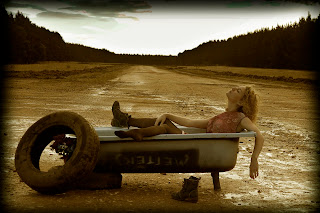The Taming of the Shrew
It is a very western notion that the landscape must be shaped to suit us, and not us shaped to the environment. We clear land for livestock and crops. We clear rainforests and build cities. This idea that we must “tame the Australian landscape” is a very colonialist idea. The idea that development means identity is something that white settlers brought to Australia, but it is clear that the future of this harsh environment was never really thought of. Over time, this sunburnt country has slowly taken its revenge by collapsing roads, washing buildings away, drying up water supplies and overgrowing cleared areas. We find ourselves searching for an Australian identity, but forever being influenced by mass media and American pop culture (the housewife, the exaggerated importance of television), as well as our own family backgrounds (searching for an English garden, bringing a foreign religion into every answer), but through influence, we often miss what is directly in front of our faces. We have treated our environment in the same harsh manner in which it survives and in turn we have become strong, hardy people, and in this way it becomes evident how the landscape has shaped people and our identities.
The landscape shapes how we view ourselves, and influences our opinions on the world. This theme was similarly explored by artist Fredrick McCubbin, and was most evident in his work, “The Pioneers”, and showed the progression of early settlers exploring and taming their environment, and as a result, becoming tough, self sufficient people. Whilst Australia may be heavily influenced by the wider world around us by culture, education and religion, we also know where we belong, and how to survive, and it is our landscape that has helped make us so.
However, the Western idea that we must conquer the worlds around us does make Austrians seem a little out of place, and our identity is still trying to form itself as we are still searching for a balance between man and environment. There is still this notion that our environment must suit us, and not we must suit and adapt to it. Artist Rosemary Laing explored a similar idea when she took the environment and carpeted it like one would a house. In a bizarre way, it almost seemed to improve the appearance of the landscape, and give it a much more tameable and accessible look to it, which to some extent is what man tries to do to the dense and ferocious environments of Australia.
As such, I wanted to explore what it meant to me to be Australian. Through stylised photographic portraits, I wanted to explore that feeling of being out of place, but belonging at the same time. By taking indoor living environments and placing them outside, I was trying to explore how ridiculous the notion is of trying to tame something that is beyond our control that many white settlers still try to attempt. The various locations that were photographed were all affected by man at some point in its history; old gravel mines filled up with water, pine plantations ripped apart, a kola reserve, with no koalas. All the places in the photographs are in the Gippsland area, a place I call home, and a place I knew well, so it made sense to photograph it. The costumes and poses were influenced by classical paintings from the renaissance to impressionist, drawing inspiration like photographer David LaChapelle from various elements like poses, colours and/or lighting. The overall sandy colour of the images is related to an international view of Australia, how when mentioned, the beach is the mental picture everyone sees, even those who live here, so I felt it was a necessary component so that it was clear where the photos were set. These images reflect an idea of how landscape effects and Australian identity and how a search for identity can shape the world around us.
this as been my work fo my final photography class EVER at monsh university, and ifelt it was only fair to share with you some of my success.






No comments:
Post a Comment